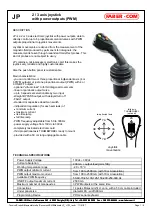
LTC3875
14
3875fb
For more information
www.linear.com/LTC3875
Single Output Multiphase Operation
The LTC3875 can be used for single output multiphase
converters by making these connections
• Tie all of the I
TH
pins together;
• Tie all of the V
OSNS
+
pins together;
• Tie all of the TK/SS pins together;
• Tie all of the RUN pins together.
Examples of single output multiphase converters are shown
in the Typical Applications section.
Sensing the Output Voltage
The LTC3875 includes two low offset, high input imped-
ance, unity gain, high bandwidth differential amplifier for
applications that require true remote sensing. Differentially
sensing the load greatly improves regulation in high cur-
rent, low voltage applications, where board interconnec-
tion losses can be a significant portion of the total error
budget. The LTC3875 differential amplifier’s positive
terminal V
OSNS
+
senses the divided output through a re-
sistor divider and its negative terminal V
OSNS
–
senses the
remote ground of the load. The differential amplifier output
is connected to the negative terminal of the internal error
amplifier inside the controller. Therefore, its differential
output signal (V
FB
) is not accessible from outside the IC. In
a typical application where differential sensing is desired,
connect the V
OSNS
+
pin to the center tap of the feedback
divider across the output load, and the V
OSNS
–
pin to the
load ground. When differential sensing is not used, the
V
OSNS
–
pin can be connected to local ground. See Figure 1.
The LTC3875 differential amplifier has a typical output slew
rate of 2V/µs. The amplifier is configured for unity gain,
meaning that the difference between V
OSNS
+
and V
OSNS
–
is
translated to its output, relative to SGND. Care should be
taken to route the V
OSNS
+
and V
OSNS
–
PCB traces parallel
to each other all the way to the remote sensing points on
the board. In addition, avoid routing these sensitive traces
near any high speed switching nodes in the circuit. Ideally,
the V
OSNS
+
and V
OSNS
–
traces should be shielded by a
low impedance ground plane to maintain signal integrity.
Current Sensing with Very Low Inductor DCR
For low output voltage, high current applications, it’s
common to use low winding resistance (DCR) inductors
to minimize the winding conduction loss and maximize the
supply efficiency. Inductor DCR current sensing is also used
to eliminate the current sensing resistor and its conduction
loss. Unfortunately, with a very low inductor DCR value,
1mΩ or less, the AC current sensing signal ripple can be
less than 10mV
P-P
. This makes the current loop sensitive
to PCB switching noise and causes switching jitter.
The LTC3875 employs a unique and proprietary current
sensing architecture to enhance its signal-to-noise ratio
in these situations. This enables it to operate with a small
sense signal of a very low value inductor DCR, 1mΩ or
less. The result is improved power efficiency, and reduced
jitter due to switching noise which could corrupt the signal.
The LTC3875 can sense a DCR value as low as 0.2mΩ with
careful PCB layout. The LTC3875 uses two positive sense
pins, SNSD
+
and SNSA
+
to acquire signals. It processes
them internally to provide the response as with a DCR sense
signal that has a 14dB (5
×
) signal-to-noise ratio improve-
ment without affecting output voltage feedback loop. In
the meantime, the current limit threshold is still a function
of the inductor peak current times its DCR value and its
accuracy is also improved five times and can be accurately
set from 10mV to 30mV in a 5mV steps with the ILIM pin
OPERATION
–
+
DIFFAMP
V
OSNS
+
C
FF
C
OUT1
FEEDBACK DIVIDER
C
OUT2
V
OUT
R
D1
R
D2
10Ω
10Ω
V
OSNS
–
–
+
+
+
EA
0.6V
I
TH
LTC3875
TK/SS
3875 F01
INTSS
Figure 1. Differential Amplifier Connection















































